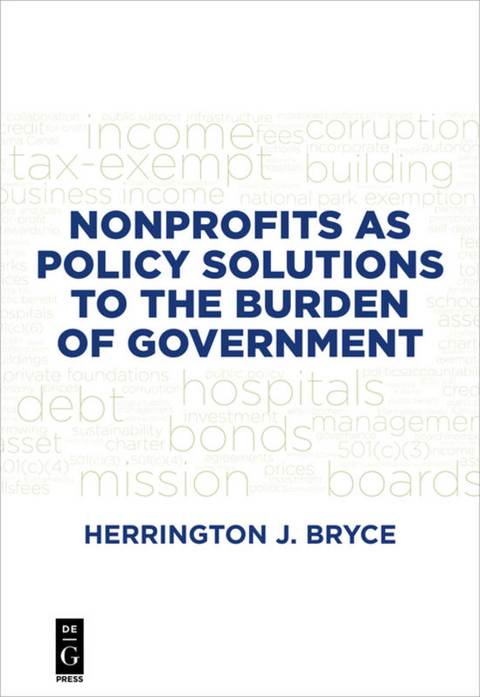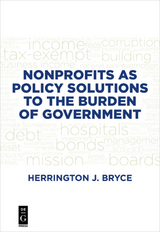Nonprofits as Policy Solutions to the Burden of Government
This book addresses a specific subset of nonprofits that are chartered with a single mission: decrease the burden of government. Designing and engaging nonprofits to lessen the burden of government requires a specific description and acknowledgement of the burden to be lessened, and these may include the provision of infrastructure, the relief of debt, or the provision of general public services that are not motivated by charity. It also requires the assignment of specific operating powers to the nonprofit including the power of eminent domain. This book explores these and other related topics including the avoidance of resource dependence on government when attempting to reduce its burden. The book is addressed to the policy makers and rule makers who design policies that affect the ability of the nonprofit to effectively lessen the burden of government. It is also addressed to public administrators in search of innovative ways of implementing these policies consistent with the laws, and to the creative nonprofit managers who are charged with carrying out the mission often in collaboration with the government or other entities. To the advanced student in all related fields, the author offers not only material for discussion, but enables discovery of what is possible by giving key examples of organizations meeting the terms and objective of lessening a significant burden of government.
Herrington J. Bryce was a senior economist at the Urban Institute, a Brookings Economic Policy Fellow, a Fellow at the Institute of Politics at Harvard and a visiting professor in regional economics and planning at the Massachusetts Institute of Technology. He taught micro economic theory and public finance at Clark University in Worcester, Massachusetts, and was director of the program in legal and budget studies at the University College at the University of Maryland. He currently teaches courses at the College of William & Mary in nonprofits but mostly in corporate financial strategy and cost management-heavily reflected in this text. He has published extensively and has served on many state, local and federal government advisory committees. He has a PhD in economics from the Maxwell School at Syracuse University, and a Clu and ChFc from the American College.
Preface | xv
Chapter 1 — Purpose, Policy, Theory, Definitions and Context | 1
Purpose | 1
The Burden of Government | 2
Perspective, Collaboration, Competence | 5
Traditional, Nontraditional, Burden | 9
Organizational Design | 11
Prices, Profits and Nonprofit Motives | 12
The Context | 13
Dimension of the Problem in the United States | 13
Why the Nonprofit Option | 16
Toward a Supporting Theory | 17
Bibliography | 18
Chapter 2 – Designing, Empowering and Engaging the Nonprofit to Lessen the
Burden of Government | 19
The National Trust for Historic Preservation | 19
Crafting the Intent to Lessen the Burden of Government | 19
Federal and State Designation of an Eligible Burden | 21
Classification of Nonprofits as Doers and Facilitators | 22
The Planks on Which to Design a Nonprofit to Reduce the Burden
of Government | 26
Plank 1: Money | 28
Plank 2: Marketing and Persuading | 32
Plank 3: Membership and Public | 32
Plank 4: Management | 33
Plank 5: The Mission | 35
Plank 6: Collaboration and Cooperation | 37
Plank 7: Tax Exemption | 37
Plank 8: Powers to Act | 38
Plank 9: Accountability | 39
Plank 10: Legitimacy | 39
Summary and Preview | 40
Bibliography | 40
Chapter 3 – Empowering the Nonprofit to Lessen the Burden of
Government | 43
The Creation of the Corporation | 44
Incorporation: Process, Purpose, Powers | 45
The Powers of the Nonprofit Corporation | 48
Prohibitions | 50
Financial Advantages and Disadvantages of Exemption | 53
Some Factors that Threaten the Loss of Tax-Exampt Status
Under 501(c)(3) | 66
Summary and Preview | 68
Bibliography | 68
Chapter 4 – Nonprofits as Doers in Reducing the Burden of Government | 69
The Doers: Distinguishing Examples | 71
Categorizing 501(c)(3) Doers | 73
Doers Depending Mostly on Business Income | 78
Subsidiaries, Affiliates, and Holding Companies as Internal
Facilitators | 80
Other Categories of Doers | 83
A General Comparison of Doers | 85
Lessening the Burden of Government: The Benefits and Justification of Tax
Exemption | 86
Summary and Preview | 87
Chapter 5 – Nonprofit as Financiers and Facilitators in Reducing the Burden
of Government | 89
Two Government-Created Examples: To Be Close But Not Controlled | 89
The Nonprofit Financers | 91
The Rules of Foundation Operation | 93
The Key Characteristics of the Facilitator | 100
Hybrids: Private Operating Foundations | 102
Summary and Preview | 104
Chapter 6 – Government Created Nonprofits to Lessen the Burden of
Government | 105
Nonprofits Created by Governments to Lessen Their Own Burdens | 106
Qualifications of a Government-Created 501(c)(3) | 108
Public Authorities as Government-Created Nonprofits to Relieve
Government Burden | 110
Ports and Powers | 113
Are Authorities Doers or Financers? | 123
Summary and Preview | 123
Bibliography | 124
Chapter 7 – Decision-Making and Governance Structure in Lessening the
Burden of Government | 125
The Board | 125
Interlocking Directorates | 129
Conflict of Interest, Independence, and Board Members | 130
Dealing With Possible Conflicts of Interest | 132
Dealing With Non-Independence | 133
Standards at the Root of All Trustee Actions | 133
Excessive Economic Transactions and Due Diligence | 137
Duty of Organizations to Trustees and Their Rights | 138
Liability of Trustees | 139
Annual Disclosures of Involvement of Current and Past Trustees and Senior
Management | 141
Summary and Preview | 142
Bibliography | 143
Chapter 8 – Financing the Burden through Contributions | 145
A General Picture of Contributions and the Sector | 145
Requirements of a Tax-Deductible Gift | 152
Problems of Accepting Gifts Subject to Debt | 158
Summary, Responsibility, and Preview | 161
Bibliography | 161
Chapter 9 – Financing the Burden through Business Earnings | 163
Business Activity as a Source of Money | 163
Definition of Related and Unrelated Nonprofit Businesses | 165
Excess Profits: A Distinction Between Related and Unrelated Income | 168
Integration of Business Operations Into a Conglomerate Structure | 169
The Organization of an Unrelated Business | 169
Tax Treatment of Different Types of Business Income | 172
Key Points on Entrepreneurial Income in Nonprofits | 188
Summary and Preview | 189
Chapter 10 – Financing the Burden through Debt | 191
The Need for a Charter and Other Documentary Powers | 191
Terms of Debt | 192
Non-Deductibility and Taxability of Interest | 194
Debt as Credit Facility | 194
Covenants, Default, Bankruptcy | 195
Strategies for Treating a Loan Due | 195
Borrowing from the Securities Market | 196
Borrowing from Nonfinancial Sources | 197
Preparing to Borrow | 197
Debt Limits and the Nonprofit | 198
Subsidized Infrastructure Debt Available to Nonprofits | 198
Long-Term Debt tor Infrastructure Used by the Nonprofit | 199
Long-Term Debt Issued by Nonprofits on Behalf of the Government for Public
Purpose Infrastructure Called 63-20 Debt | 200
Issuing of Debt (Bonds) by an Authority | 202
Debt Through Tax Increment Financing | 205
Long-Term Lease Arrangements of Property | 206
Summary and Preview | 206
Bibliography | 206
Chapter 11 – Establishing Cash Flows for Sustainability | 207
The Trust | 208
Endowments: Perpetuating a Gift | 209
Specific Long-Term Assets In an Endowment: Trusts | 213
Specific Long-Term Assets for Endowments: Life Insurance Policies | 216
Gifts of Iras, Gift Annuities, and Other Such Contracts | 222
The Power of a Will | 223
Summary and Preview | 224
Bibliography | 224
Chapter 12 – Corruption and Control: Protecting the Assets for Lessening the
Burden of Government | 225
Corruption | 225
Types and Effects of Corruption in Nonprofit Organizations | 226
Sources and Opportunities for Corruption | 228
Managing the Risks of Corruption and Fraud | 230
Controls: An Accounting Approach | 230
Controls: A Transaction Approach | 231
Controls: A Flow Approach | 232
Controls: Organizational Lines of Defense | 233
A Comprehensive Approach to Corruption | 234
The Discovery of Corruption | 237
The Protection of Sources and Records | 237
Insurance Against Corruption | 240
Classification and Treatment of Certain Costs | 242
A Tool of Cost Control, Avoidance of Cost Overruns, and Detection of the
Risk of Inefficiency or Fraud | 246
Summary and Preview | 248
Bibliography | 248
Chapter 13 – Discussion and Dialogue | 251
Levels of Lessening the Burden of Government | 252
Types of Nonprofits Lessening the Burden of Government | 253
The Authority to Perform | 254
The Nature of the Promise to Lessen the Burden of Government | 255
To Exercise Authority the Nonprofit Needs Powers | 255
The Power to Finance and the Motive for Action | 256
Governance Structure | 256
Accountability and Disclosures | 257
Types and Range of Collaboration | 258
The Conflict Between Collaboration and Control | 258
Sources of Legitimacy | 259
Growth and Competition | 261
Debt and Off-Balance Sheet Financing | 262
Who Subsidizes Whom | 264
Tax Exemption as Price and Incentive | 264
The Rationale for This Direction | 265
Index | 269
| Erscheinungsdatum | 24.01.2017 |
|---|---|
| Verlagsort | Boston |
| Sprache | englisch |
| Maße | 155 x 230 mm |
| Gewicht | 498 g |
| Themenwelt | Sachbuch/Ratgeber ► Beruf / Finanzen / Recht / Wirtschaft ► Wirtschaft |
| Recht / Steuern ► Steuern / Steuerrecht | |
| Wirtschaft ► Betriebswirtschaft / Management ► Allgemeines / Lexika | |
| Wirtschaft ► Betriebswirtschaft / Management ► Planung / Organisation | |
| Wirtschaft ► Betriebswirtschaft / Management ► Unternehmensführung / Management | |
| Wirtschaft ► Volkswirtschaftslehre ► Wirtschaftspolitik | |
| Schlagworte | Nachhaltigkeit • naechstenliebe • Nonprofit-Organisation • Nonprofit, Public Management, Policy, Sustainability, Public Debt, Infrastructure, Collaboration • Nonprofit-Sektor • öffentliche Ordnung • Staatsgewalt |
| ISBN-10 | 1-5015-1473-3 / 1501514733 |
| ISBN-13 | 978-1-5015-1473-9 / 9781501514739 |
| Zustand | Neuware |
| Informationen gemäß Produktsicherheitsverordnung (GPSR) | |
| Haben Sie eine Frage zum Produkt? |
aus dem Bereich




